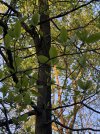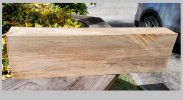You are using an out of date browser. It may not display this or other websites correctly.
You should upgrade or use an alternative browser.
You should upgrade or use an alternative browser.
Any idea as to type of wood?
- Thread starter spartyon8
- Start date
If the leaves turn to a brilliant red in the Fall, it is probably black gum.
It looks like the many black gum trees around my yard. Pretty nice leaves with shiny leaves that turn a bright red in the fall.
Blackgum (Nyssa sylvatica)
www.carolinanature.com
It is in the middle of our yard and my wife wants me to take it down. Is the wood worth keeping and drying?
I'm curious. Why does your wife want this particular tree removed out of all of the many other trees in the middle of your yard? Are the others oak or maple in the background?
Black gum is not related to sweetgum and I don't know how it will be if you try to save some of the wood.
It is smack in the middle of the yard and looks out of place. The trees in the behind it are just on the other side of the fence line. We also have an algae/mold problem on the back side of the house where this tree is located. I thought it would also open up some more sun to help with that.
It is smack in the middle of the yard and looks out of place. The trees in the behind it are just on the other side of the fence line. We also have an algae/mold problem on the back side of the house where this tree is located. I thought it would also open up some more sun to help with that.
Good reasons to remove it. Carry on.
A friend was clearing a pasture a few years back and was taking down some black gum (sometimes called tupalo) and I snags some and turned some bowls...

It turned ok, but split easily allong growth rings. Least desirable was that it took on a "muddy" appearance and lacked any redeeming grain pattern.
I'm not sure how it would be for furniture, but I wouldn't go out of my way to get any more
It turned ok, but split easily allong growth rings. Least desirable was that it took on a "muddy" appearance and lacked any redeeming grain pattern.
I'm not sure how it would be for furniture, but I wouldn't go out of my way to get any more
It is part of the Tupelo family of trees, Off white color/yellow to brown, not consistent,
It can twist and check when drying, Because it has a more porous type grain when dry it must be sealed correctly or it will experience movement. To me it is kinda like Poplar, tbh, a wood a rarely use except of backing. You might keep one section and a couple bucks to turn bowls with, just for curiosity.
It can twist and check when drying, Because it has a more porous type grain when dry it must be sealed correctly or it will experience movement. To me it is kinda like Poplar, tbh, a wood a rarely use except of backing. You might keep one section and a couple bucks to turn bowls with, just for curiosity.
Like any other wood, black gum can have major variations. I have turned some that was bland and others that had spectacular grain. You could also cut some turning blanks out and put them in the shade with some shavings on the top. Let them sit for a few weeks and then you might have some really nice spalted wood. When the tree is down, you can inspect the cut surfaces and see what it might have in terms of potential. At the least, it is wood available for turning and the practice is fun.
Roy G
Roy G
Thanks for all the replies. I might hack it up in pieces for the lathe.
It's worth a try and if it doesn't work send it to the wood stove. BTW, black gum is not the same species as Tupelo but it's often thought that they're the same species.
Tupelo, Poplar, Black Gum Are related, but they are not the same tree, but are of the same class and order of tree types.
They all belong to the Nyssa family group of trees, this would include: The Black Gum, the Sour Gum, the Swamp Gum, the Tulip, Poplar and Tupelo.
Nyssa sylvatica - Plant Finder
They all belong to the Nyssa family group of trees, this would include: The Black Gum, the Sour Gum, the Swamp Gum, the Tulip, Poplar and Tupelo.
Nyssa sylvatica - Plant Finder
LATEST FOR SALE LISTINGS
-
-
-
SOLD -- $75: Gast moa v113 Vacuum Pump Veneer, 60" bag and board
- Started by peterdnight
- Replies: 1
-
GONE: Gladiator 5 cleats, 10 hangers, Paper Towel and Shelf
- Started by peterdnight
- Replies: 3
-
SOLD -- $100 Makita mac700 portable air + grex pin nailer + 2 others + 50' hose
- Started by peterdnight
- Replies: 1


